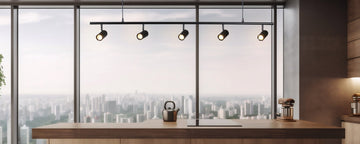LED is fast becoming the preferred light source for lighting today’s homes and businesses, not only for its excellent energy efficiency but also because the familiar incandescent light bulb is being phased out in favor of LED. However, for most consumers, confusion still reigns when it comes to selecting an integrated LED light fixture or replacing a traditional bulb with an LED bulb.
We’re here to help!
There are three must-know terms for selecting a new LED fixture or shopping for LED replacement bulbs: Watts, Lumens, and Kelvin.
Watts and Lumens
Most people are familiar with the term “watts.” It was easy to go into a store, select a 40, 60, 75, or 100 watt incandescent light bulb, and be reasonably sure that the brightness of the bulb was as expected – 40 watts was dimmer, and 100 watts was brighter. Now, with LED bulbs, the term “lumens” has come into play.
LED bulbs use a different technology than traditional bulbs (they do not heat a filament to produce brightness). LEDs use far less energy to generate light, so their wattage is much lower when compared to traditional bulbs. For example, a traditional 60-watt light bulb emits over 800 lumens. An LED equivalent may only measure 8.5 watts, but it will still emit 800 lumens and provide the same brightness levels. Therefore, when selecting an LED, look for the LED’s brightness level rated in lumens, not watts.
Kelvin
Kelvin (K) is defined as the color appearance of the light as measured on the Kelvin scale. A bulb with a lower Kelvin number provides warmer, yellowish light, while a higher Kelvin number means cooler, bluer light.
Select a bulb with a 2000 – 3000K color temperature for a warm white light to give rooms a cozy, calm, and intimate ambiance. A bulb with a 3100 – 4500K color temperature offers a cool white light and is ideal for spaces such as work areas or offices that require bright, vibrant light. Bulbs above 4500K head into the “daylight” range – this color temperature offers a crisp, blue-white light and its use is generally limited to areas that need very bright light, such as security lighting or display areas.
The LED light bulb packaging will have the relevant lumen-to-wattage equivalency as well as color temperature information. If you’re selecting an integrated LED fixture, which is a lighting fixture with the LED light source already built into it, the lumen and color temperature information will be specified in the manufacturer’s literature.














